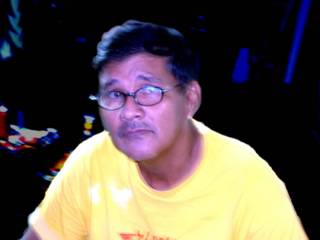BEAUTY AMID TROUBLED PARADISE
(THE ART OF JUN ALFON)
Photo by Mano Dela Rosa, 2004. Posted by Hello
Swinging between folk art and abstractionism, this prolific artist from Mindanao has masterfully explored both genres with ease and eloquence.
Known for the elegant and intricate portrayal of tribal women, Jun Alfon captured the true essence of Filipino art by depicting the multi-ethnic motifs of Mindanao’s diverse culture. His art seduces and mesmerizes the audience with the enchanting presence of his exotic women, bedecked with the intricate ethnic designs and vibrant colors, so entrancing that one could almost feel the drumbeat, the sound of kuglong, and the mystical dance steps of baylan.
Known for the elegant and intricate portrayal of tribal women, Jun Alfon captured the true essence of Filipino art by depicting the multi-ethnic motifs of Mindanao’s diverse culture. His art seduces and mesmerizes the audience with the enchanting presence of his exotic women, bedecked with the intricate ethnic designs and vibrant colors, so entrancing that one could almost feel the drumbeat, the sound of kuglong, and the mystical dance steps of baylan.
Three Women by Jun Alfon, 2004, Oil on Canvas.
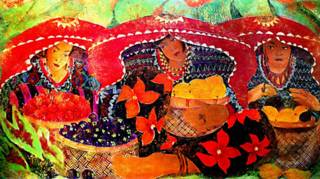
Photo by Mano Dela Rosa. Posted by Hello
As a folk artist, Jun Alfon is one of the the forerunners of Filipino tribal art on canvas. Growing up in the multi-cultural environment of Mindanao, which consists of Christians and Muslims, multi-ethnic tribal communities, the mestizos and the mestizas of Spanish descent and the migrants coming from different islands of the Philippines, Jun Alfon’s art is rooted within the complex convergence of cultures in his native land.
Posted by Hello
Aside from being a painter, the artist is also passionate about the multi-ethnic backgrounds of his people and their diverse cultural practices by chronicling them through the unflinching lens of his camera.
His photographs are equally compelling as his works on canvas. Unlike his paintings, however, his camera captures the essence of his subjects in a theatrical manner: the drama between his people and their cultural identities with dignity and elegance.
Kadayawan Festival, Photo by Jun Alfon.
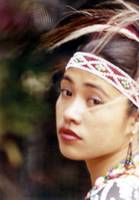
Posted by Hello
As a photographer, he immerses himself with his subjects, a unique quality not common to photographers, whose relationship with the subjects is distinctly divided between art and professionalism.
Tiboli Woman, Photo by Jun Alfon.
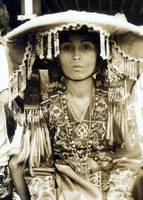
Posted by Hello
Jun Alfon is also a portraitist whose mastery of pastel on paper renders a unique glance of character glowing with tonal values and colors. “Drawing…” according to neo-classicist Jean-Auguste-Dominque Ingress,”…is the probity of art”. Jun Alfon’s drawings and portraits go beyond the classical concept, as they are intimately warm and tangible, reflective of the artist’s personality.
In essence, the classical draftsmanship of his art is highly influenced by the intricate and complex tribal designs in Mindanao. Like for instance, the stylish headdress of the Tiboli, the geometrical designs of dagmay by the Mandayas, the colorful malong and tubao of native Muslims and other ethnic designs that are pullulating with exotic forms and colors.
Babaylan by Jun Alfon, 2004, Oil on Canvas.
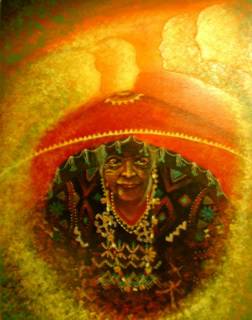
Photo by Danny Sillada, 2004. Posted by Hello
Even in his abstract paintings, he consistently employs the tribal motifs and colors with suave and sophistication. In like manner, his abstraction is not confined within the canon of po-mo art but rather explores the relationship of other genre with continuity and dynamism. It is like an extension of his other mediums, rather than a departure from the cultural roots of his aesthetics.
Native Muslim, Photo by Jun Alfon
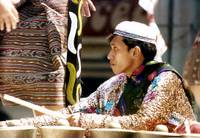
Posted by Hello
Aside from being a painter, the artist is also passionate about the multi-ethnic backgrounds of his people and their diverse cultural practices by chronicling them through the unflinching lens of his camera.
His photographs are equally compelling as his works on canvas. Unlike his paintings, however, his camera captures the essence of his subjects in a theatrical manner: the drama between his people and their cultural identities with dignity and elegance.
Kadayawan Festival, Photo by Jun Alfon.

Posted by Hello
As a photographer, he immerses himself with his subjects, a unique quality not common to photographers, whose relationship with the subjects is distinctly divided between art and professionalism.
Tiboli Woman, Photo by Jun Alfon.

Posted by Hello
Jun Alfon is also a portraitist whose mastery of pastel on paper renders a unique glance of character glowing with tonal values and colors. “Drawing…” according to neo-classicist Jean-Auguste-Dominque Ingress,”…is the probity of art”. Jun Alfon’s drawings and portraits go beyond the classical concept, as they are intimately warm and tangible, reflective of the artist’s personality.
In essence, the classical draftsmanship of his art is highly influenced by the intricate and complex tribal designs in Mindanao. Like for instance, the stylish headdress of the Tiboli, the geometrical designs of dagmay by the Mandayas, the colorful malong and tubao of native Muslims and other ethnic designs that are pullulating with exotic forms and colors.
Babaylan by Jun Alfon, 2004, Oil on Canvas.

Photo by Danny Sillada, 2004. Posted by Hello
Even in his abstract paintings, he consistently employs the tribal motifs and colors with suave and sophistication. In like manner, his abstraction is not confined within the canon of po-mo art but rather explores the relationship of other genre with continuity and dynamism. It is like an extension of his other mediums, rather than a departure from the cultural roots of his aesthetics.
Native Muslim, Photo by Jun Alfon

Posted by Hello
Swinging from one genre to another, Jun Alfon never loses the quality and aesthetic identity of his art. The dynamism of his creativity is traceable to his cultural environment in Mindanao - how art becomes an indispensable medium within the cultural practices and rituals of its people.
Conversely, the multifaceted art and culture in Mindanao is not static, but an art of action fillwd with rituals, festivities and celebrations. Generally, Mindanaoan artists, consciously or unconsciously, imbibed these influences on their art.
Conversely, the multifaceted art and culture in Mindanao is not static, but an art of action fillwd with rituals, festivities and celebrations. Generally, Mindanaoan artists, consciously or unconsciously, imbibed these influences on their art.
Muslim Women, Photo by Jun Alfon.

Posted by Hello
Art in Mindanao is synonymous with action infused with animism and ritual. Among the native Muslims and tribal communities, art is the manifestation of their daily lives and their lives are the soul of art, tradition and culture. Their intimate relationship with nature enriches that sense of dynamism and joie de vivre through the ceremonial dances and music, costumes and ritualistic performances. Nature is alive with spirits and art is the tangible expression of those spiritual and supernatural encounters with nature and spirit.
Contrary to the general impression about the belligerent environment of Mindanao due to some dissenting Muslim brothers and Christian rebels, Mindanao is like a paradise whose exotic beauty is teeming with magic and wonders. Her verdant lands and mountains, her crystal-clear streams and rivers, and her flora and fauna are natural wonders unique to this paradise.
Mansaka, Photo by Jun Alfon.

Posted by Hello
Mindanao is also known as the Land of Promise, needless to mention her wealth and beauty. But it is also the land of broken people and unfulfilled dreams because of political and economic convulsions, which the Philippine government failed to address for decades. Despite her brokenness, Mindanao remains a paradise yet to be explored and discovered by her own people.
Within a three-decade self-exile from Mindanao, Jun Alfon consistently tells the story of Promised Land through his art, as reflected on the intricate forms and colors on his canvas. His art emerges with no pretensions and speaks of, as it has always been, the splendor and beauty of his paradise.



